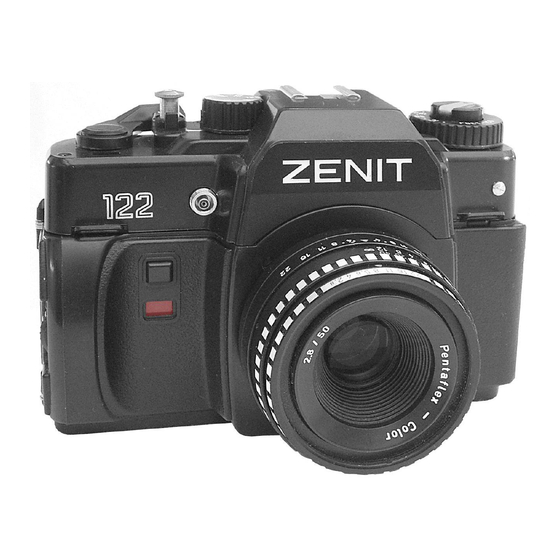
Advertisement
Table of Contents
ZENIT-122
This text is identical to the one in the Instruction Manual, English version, 1992 year.
1. Purpose and advantages
ZENIT-122 is a 35-mm single lens reflex camera intended for taking various amateur pictures on
black-and-white and color films. It can be used for special kinds of photography as well, such as
copying, taking close-up pictures of small-size objects at short distances (ultra-close-up photography),
taking pictures with the help of a microscope (photomicrography), etc.
The camera accepts interchangeable lenses with M42x1 screw fittings and mechanical back focal
distance of 45,5 mm.
The following features are remarkable with the camera:
semi-automatic exposure meter operating through the lens (TTL system) provides for correct
•
exposure setting when taking pictures with the standard lens as well as with interchangeable
lenses, light filters, supplementary lenses, extension tubes;
light-emitting diodes in the viewfinder, indicating correct exposure setting, can be clearly seen
•
both with the diaphragm fully open and stopped down;
instant return mirror ensures continuous viewing of a subject before ;and after exposure;
•
high speed lens is provided with a pre-set diaphragm mechanism which automatically closes
•
the diaphragm down for the moment of shutter operation;
fully open diaphragm ensures maximum brightness of the image in the view-finder which is
•
very important for viewing and focusing;
composite focusing device provides excellent image sharpness in various conditions of
•
shooting;
speedy exposure setting, simplified film loading procedure and frame counter automatically re-
•
setting to "0" upon pressing the film rewind button reduce the time required for preparing the
camera for picture taking;
built-in self-timer enables you to take picture of yourselves among your friends or to make a
•
self-portrait;
secret lock of the back door interlocked with the film rewind knob provides for reliable locking
•
of the back door and convenient unloading of the camera;
flash unit connector socket and hot-shoe enable to use flash units both with cable and cableless
•
connection;
shutter disengaging bush of stay-put type simplifies the film rewind procedure;
•
film-checking pocket on the camera body contains characteristics information of the film the
•
camera is loaded with.
Before using the camera, make thorough study of the present Description. In so doing bear in mind
that the present Description can not be regarded as a handbook on photography.
Due to ever-advancing development in camera construction, minor differences may occur between
the text and your camera.
2. Handling Rules
The camera is a precise optical-mechanical instrument. It should be handled carefully, kept clean and
protected from jolts, dust, moisture, and sharp temperature fluctuations.
Zenit 122
– 1 –
User manual, 1992 year
Advertisement
Table of Contents

Summary of Contents for Zenit Zenit 122
- Page 1 This text is identical to the one in the Instruction Manual, English version, 1992 year. 1. Purpose and advantages ZENIT-122 is a 35-mm single lens reflex camera intended for taking various amateur pictures on black-and-white and color films. It can be used for special kinds of photography as well, such as copying, taking close-up pictures of small-size objects at short distances (ultra-close-up photography), taking pictures with the help of a microscope (photomicrography), etc.
-
Page 2: Specifications
ZENIT-122 User manual, 1992 year Do not remove the camera from its case the moment it is brought indoors from cold to avoid sweating of its parts, especially the optical ones. Do not touch the surfaces of the optical parts with fingers since it may damage their coatings. Clean the optical coated lens surfaces with a clean soft cloth or cotton wool wad slightly moistened with rectified alcohol or ether. -
Page 3: Camera Design
ZENIT-122 User manual, 1992 year 4. Camera Design 1 — self-timer cocking handwheel 2 — self-timer release button 3 — self-timer window 4 — flash unit connector socket 5 — release button threaded for cable release 6 — shutter disengaging knob of stay-put type 7 —... - Page 4 ZENIT-122 User manual, 1992 year 27 — distance scale 28 — depth-of-field scale 29 — aperture scale 30 — lens mounting ring 31 — control pin 32 — aperture setting ring 33 — focusing ring 5. Camera loading Put the batteries into the camera in the following way: turn cap 22 counterclockwise so that its slot take the horizontal position, remove the cap and take out the exhausted batteries should there be any.
-
Page 5: Shutter Speed Setting
ZENIT-122 User manual, 1992 year 6. Shutter Speed Setting Turn the shutter speed dial 17 to bring a selected shutter speed opposite to the index mark 18 on the camera top plate. In so doing the dial is click-stopped. Figures on the shutter speed dial show shutter speeds in corresponding fractions of a second and “B”... - Page 6 ZENIT-122 User manual, 1992 year 9. Exposube Setting with the Help of Exposure Meter The camera semi-automatic exposure meter measures the light passing through the lens (TTL system). As a result, making use of various combinations of aperture and shutter speed values, you can set the exposure depending upon the brightness of can object and the speed of film being used with a high degree of accuracy.
- Page 7 ZENIT-122 User manual, 1992 year — flip open crank 12 and rotate it in the arrow direction until the film leaves the take-up spool. Try and rotate the crank smoothly, without jerks, and not too fast to avoid traces of static electricity on film;...
- Page 8 ZENIT-122 User manual, 1992 year With the help of a special stand the camera can be used for making copies of drawings, manuscripts, photographs. To do this use should be made of extension tubes by setting them between the camera body and the lens. To obtain the magnification you want either one tube or a combination of some tubes can be used.



Need help?
Do you have a question about the Zenit 122 and is the answer not in the manual?
Questions and answers